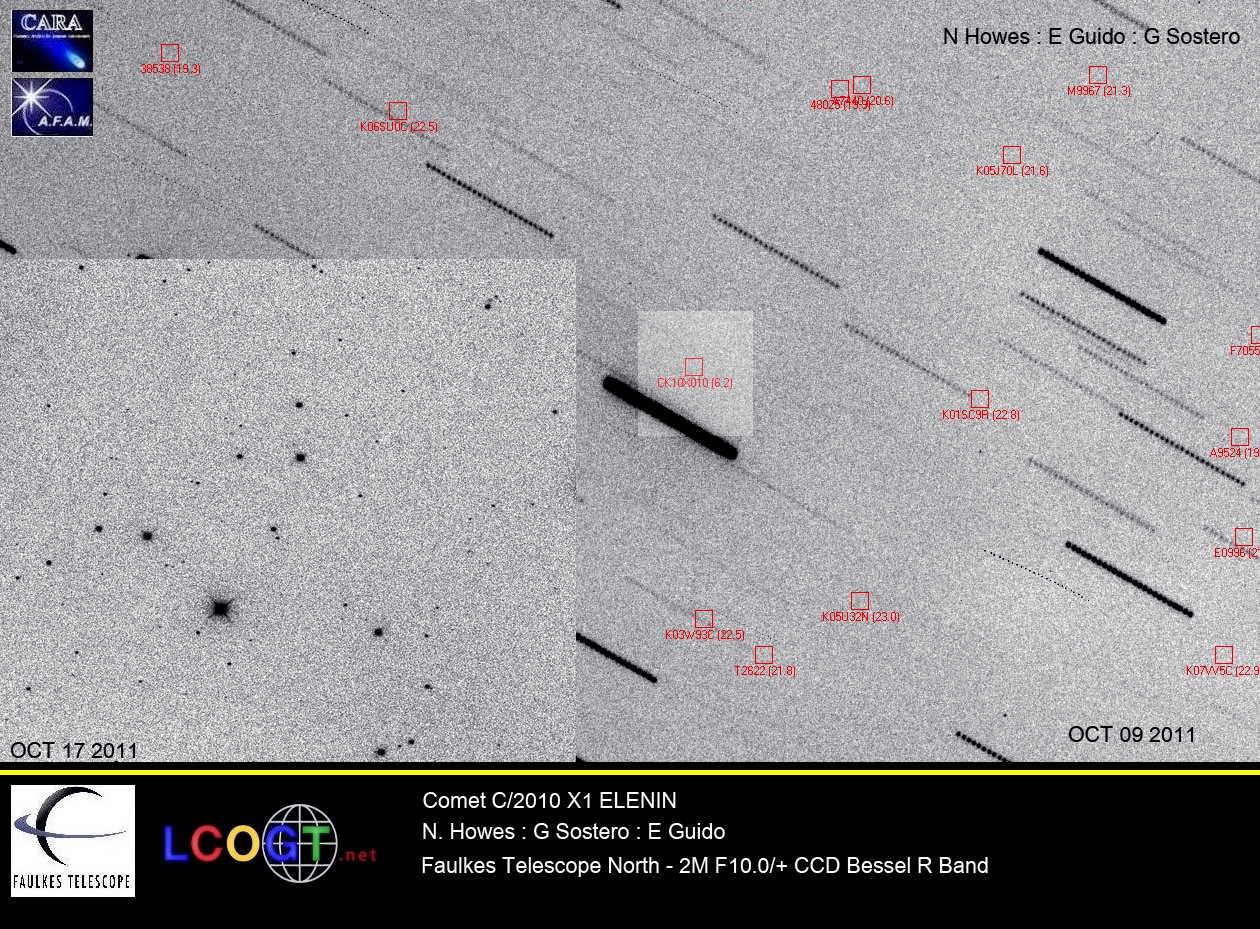[/caption]
If you were waiting for Comet Elenin to wreak havoc on Earth so that you didn't have to pay off your credit card debt or go into work today, I'm sorry to inform you that doomsday didn't happen. All that remained of Comet Elenin, -- which wasn't much -- made its closest pass by Earth yesterday (Oct. 16, 2011) without causing any earthquakes, tsunamis, or high tides and it didn't collide with Earth, either. Moreover, there was no brown dwarf or Mothership hidden in the comet's coma. And in case you didn't notice, this comet did not cause three days of darkness around September 26, 2011.
"I don't know why fearmongers chose my comet," the comet's discoverer
Leonid Elenin
told Universe Today. "I received many letters from scared people. But if they believe in conspiracy theories I can't help them."
For some reason, conspiracy and doomsday theorists chose this small little comet -- one that was to come no closer to Earth than 34 million km (21 million miles) during its closest approach on October 16th – to be the harbinger of doom.
But here we are, just fine.
Well, except for wars, terrorism, global warming and other things that the human race inflicts on itself. There are enough bad things going on here on planet Earth that conspiracy theorists shouldn't fabricate doomsday predictions just to needlessly scare people for fun and profit.
So why
didn't
Comet Elenin cause doomsday?
1.
It couldn't have hit Earth, or affected Earth's orbit. The comet was predicted to come 34 million km (21 million miles) away at its closest approach. Just in case you can't figure that out, one object can't hit another at that distance. Plus, the gravity exerted by a small object won't affect Earth either. To put this in perspective, this distance is only a little closer than the closest approach of Venus to Earth, and roughly 100 times the distance from the Earth to the Moon. Nothing happens to Earth when Venus is at closest approach, and Venus is 12,000 kilometers in diameter, while Elenin was 3-5 kilometers across. When the comet was intact it had less than a billionth of the tidal force of the Moon.
[caption id="attachment_89980" align="aligncenter" width="580" caption="Where Comet Elenin should have been in the sky on October 16, 2011 shows nothing left of the the distinegrated comet, and all that is visible are star trails. Credit: Ian Musgrave, using the Global Rent-a-Scope."]
[/caption]
2.
Comet Elenin fell apart. Sometimes, long period comets that originate from the outer parts of our solar system begin to dissipate as they get closer to the Sun. But Elenin was hit by solar flares from the Sun on August 19 and began disintegrating. When it reached its closest point to the Sun on September 10, it basically was toast. Just recently the location of where the comet should be has become visible in the night sky, out of the Sun's glare. Several images from different amateur astronomers show absolutely nothing. The comet has completely disintegrated and fallen apart.
Earlier today, astronomer Nick Howes and his colleagues using the 2 meter
Faulkes telescope
took 30 minutes worth of exposures and saw nothing of Comet Elenin in the sky (top image). "We observed objects at magnitude 20.5, but saw no trace at all of Comet Elenin," Howes told Universe Today. "If it had stayed together, it should have been almost visible with the naked eye now."
3.
What is left of the comet won't cause problems, either. The average density of a comet's coma is about the same as the density of the atmosphere on the Moon, and any rocks or debris that might be left over from the comet are small enough that they would burn up in Earth's atmosphere if Earth does go through the wake of the coma or debris from the comet. And remember, several times a year Earth goes through the debris from comets and all that happens is we get beautiful
meteor showers
to enjoy.
And after this, don't worry about Comet Elenin or its leftovers. Earth won't pass through it again for another 12,000 years.
So move along, folks, nothing here. Comet Elenin is just
another doomsday that didn't happen
, just like
NASA
,
Leonid Elenin
, and
many other people
said.
And if you proudly claim you aren't a
sheeple
and are now just waiting and searching for the next doomsday theory to hang your every hope upon, why don't you try expending your energy on this: Enjoy every day on this beautiful planet and live your life in its fullest. Use
real
science and learn to think critically. And perhaps you could be a person who could help come up with solutions to some of the real problems on planet Earth.
(And by the way, don't worry about Oct. 21, 2011 (Harold Camping makes another prediction) or Dec. 21, 2012 (Mayan calendar) either. Same story.)
Second image source:
Astroblog by Ian Musgrave
 Universe Today
Universe Today
